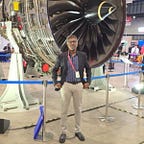Designs lessons from the Nature
Nature speaks to us continuously even though we tend to ignore it. It communicates with us through the ecosystem with such an absolute masterstroke, from which we can learn tons of lessons to imitate and solve our real world problems. I am going to tell you a story of an engineer who worked for the railways in Japan.
When the bullet trains zoomed across the cities, every Japanese was excited with a great pride of their technological feat. However, the enthusiasms began to wane as fast as the train which created a boom at the exit of the tunnels. It is the physical effect of the compressed air inside the tunnel coming out as an impulsive noise (or pressure wave) when a speeding bullet train at 350 km/h, exits it.
(Image Credit: https://www.researchgate.net/publication/225752994_Numerical_and_experimental_investigation_of_wave_dynamic_processes_in_high-speed_traintunnels)
It was troublesome and annoyance for the near-by dwellers up to 400m. You can experience the “tunnel boom” from videos posted in the YouTube channels.
The Shinkansen engineers rolled up their sleeves to solve the problem, but all in vain. In 1994 Eiji Nakatsu, an engineer and an avid avian enthusiast stumbled upon an idea of applying solutions inspired from the nature.
His first focus was on the kingfisher. If you closely observe the kingfisher diving with its nose first into the water to catch fish, it barely makes a splash around.
(Image Credit: http://www.storytrender.com/15693/retail-boss-nails-flawless-kingfisher-water-dive-shot-almost-50000-pics/)
It’s sharp beak gently deflects the water away and its head takes a plunge to snag its prey. It is the most efficient animal on earth to transition from low pressure (air) to high pressure (water). The tunnel boom problem is also about the transition between the two different pressure zones.
Nakatsu gave his train a “long conic beak” nose up to 50 feet in the front portion of it. It not only reduced — the tunnel boom — noise by 35%, but also increased the speed by 10% with 15% less electric power consumption. Nakatsu hit not just one but three birds with one stone…
(Image Credit: https://uxdesign.cc/shinkansen-the-bullet-train-inspired-by-kingfishers-bf6173cc5eae)
Yet… Nakatsu was not quite happy.
There are pantograph wings above the carriages to connect with the power lines running along. The ultra high speed and the deflected air caused the vibration of pantograph which became the new source of loud fluttery noise. Many engineers gave traditional solutions which increased the cost or weight or both.
(Image Credit: https://www.flickr.com/photos/aucklandtransport/12940899704)
Nakatsu decided again to take an inspiration from the nature. A spark of idea that the concave face of an owl is capable of absorbing sound, led him to a different perspective.
(Image Credit: https://www.nathab.com/blog/video-owls-have-heads-designed-for-hearing/)
An owl’s concave face helps absorb sounds for improved hearing by suppressing unwanted noises. Its body has ample down to absorb fluttering sounds. Tiny serrations on its primary feathers minimise the vortex generated by its movements. Nakatsu applied these concepts in the design of pantographs. He changed the pantograph wings similar to that of the owls and successfully dampened the rushing air turbulence.
Thus the design inspirations taken from the kingfisher and the owl resulted in a quieter impact for residents near the tracks.
Yet again, Nakatsu was not happy…
The support-base of the pantograph posed a threat of failure due to the high wind resistance because of the improved aerodynamics of other parts. Once again he derived inspirations from the nature to solve this problem, but this time from the Adelie Penguin. The penguins swim effortlessly in water to catch fish because its body is shaped like a spindle.
(Image credit: https://www.express.co.uk/life-style/top10facts/664228/top-ten-facts-things-you-didnt-know-about-penguins)
Nakatsu modified the base support mimicking the spindle shaped penguin and cleared up the problems once for all. The pantograph has now taken the shape to withstand the vibration and the wind resistance at the high speed of 400 km/h.
(Image Credit: https://www.csuci.edu/news/releases/2017-bullettrain.htm)
We always value and appreciate one’s ripe experience as a source of knowledge. However, the nature took 3.8 billion years of evolution to solve such “engineering” problems harbouring secrets and vast experience in them. Let us hear the nature and pay attention to its voice.
